We Must Pair Raise the Age with Restorative Justice
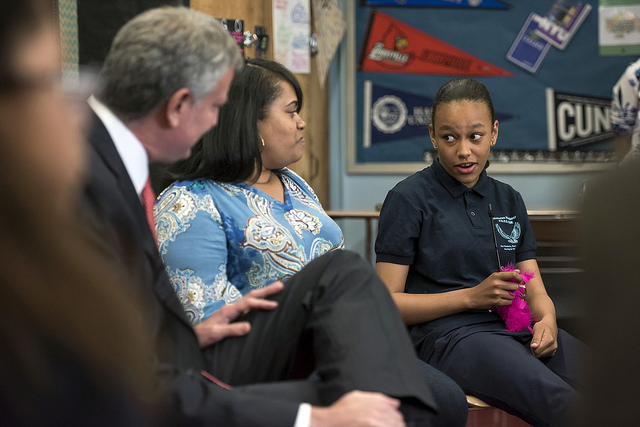
Mayor de Blasio in a restorative circle (photo: Ed Reed/Mayor’s Office)
There has been a great deal of celebration following passage of “Raise the Age,” legislation in New York that will end the practice of trying 16- and 17-year-old criminal defendants as adults. And rightfully so -- this will go a long way to dam the school-to-prison pipeline; we should be cheering. But rarely does a key strategy that helps students make better decisions and avoid arrest make headlines: restorative justice.
Like our justice system, our schools need to move away from overly punitive consequences and invest the resources to implement practices that address the root causes of misbehavior and set students on a path to long-term success.
Students need supports, not suspensions, to grapple with the larger problems that often lead to their misconduct. Students who have experienced trauma come to school carrying emotional baggage that impacts how they act in class. In low-income communities, such as the one I have served for six years, it is not uncommon for students to have suffered trauma from poverty, violence, and discrimination. I have a student who has bounced around foster families. Another student witnessed his dad get beaten by gang members. Relying on inflexible, insensitive, zero-tolerance discipline policies only compounds the mental, emotional, and academic damage from trauma and does not give students the tools to deal with challenges constructively and overcome them.
Even as New York has made a huge push to reduce suspensions, little has been done to support educators like myself to learn alternatives, such as restorative justice practices. Three years ago, I transitioned from my role as a math teacher to a dean. Teachers would send misbehaving students to my office, and I would hear their infraction, and unaware of alternatives, I would administer the punishment school protocol decided was appropriate. But after my first year, I knew detentions and suspensions were not having a long-term impact on student behavior. Unsure of a better way to handle discipline, I leaned on my abilities to foster relationships with students that I had honed as a teacher. As I began to see success with this approach, I sought out methods that leveraged relationships to improve behavior and stumbled on restorative practices.
The restorative approach to discipline is anathema to most educators’ training, and making the shift from punitive to restorative takes time, training, and buy-in.
Although my district offered little guidance, I knew I had to initiate this change for the sake of my students. In my free time I watched restorative justice videos on YouTube and attended external professional development. Transitioning from a punitive mindset, in which I evaluated a child’s misstep and doled out the commensurate consequence, to a restorative mindset, in which I sought to understand and address the cause of the misstep, was transformative. But it was also a difficult journey that could have been made easier with assistance from the district.
Now when students enter my office, they come in knowing we will have restorative conversations seeking to get to the root of the issue that brought them there. Students take responsibility for their actions and together we determine how to heal the situation.
An example of this was a recent fight between two high school students. Instead of suspensions, together they worked on a powerpoint on the perils of fighting and presented their findings to an eighth-grade group. Through this activity, the students learned from their mistakes, repaired the damage, and took responsibility to share their knowledge. That is the power of restorative justice; a suspension could never have achieved these outcomes. Interventions like these have reduced our suspensions by 55 percent. Imagine the difference if every school used restorative justice, and if the resources were there to help them do it.
But the beauty of restorative justice is not just the numbers, it’s the relationships. My teachers have seen the power of these relationships, and are taking it upon themselves to bring restorative justice to their classes. Now educators, and even student leaders, are spearheading restorative justice practices in my school. But they, and others around the state, need help. It’s time that New York build on it’s Raise the Age reforms by training our teachers in positive behavioral interventions that keep our kids in schools, not prisons.
***
Barry Price has been a math teacher, dean, and basketball coach for 11 years and is a member of Educators for Excellence-New York.
***
Have an op-ed idea or submission for Gotham Gazette? Email This email address is being protected from spambots. You need JavaScript enabled to view it.
Every Child Needs Access to Mental Health Services
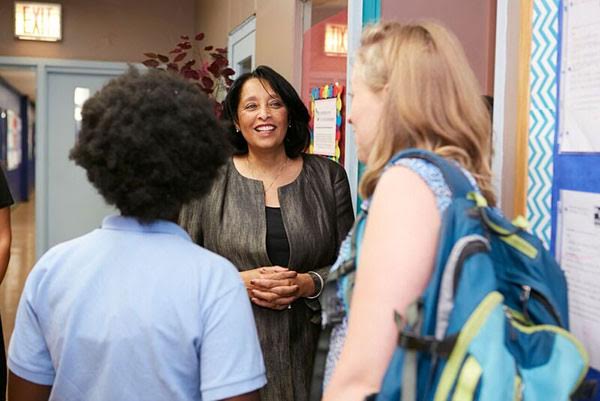
(Dr. Thelma Dye, the author)
Prince Harry’s recent admission he is seeking treatment to come to terms with his mother’s death made headlines across the globe and for good reason. As recently as 20 years ago public opinion polls here in the U.S. found more than half the country believed depression was a sign of personal or emotional weakness. So when one of the world’s most recognizable and influential figures says not even a royal is immune to mental health challenges, it can have a significant impact.
Harry, along with his brother and sister-in-law, the Duke and Duchess of Cambridge, have started an advocacy campaign to remove the stigma of mental illness worldwide, primarily aimed at reaching the younger generations. Given that two out of every three children experience a traumatic event by their 16th birthday, this effort couldn’t have a better audience.
In working with children and families for more than 20 years here in New York City, I have seen firsthand how addressing mental health issues at an early age leads to better learning outcomes, stronger family relationships, and improved life outcomes. It’s not a secret that mental health is as critical as physical health in a child’s long-term development, and child psychiatrists see that every day in their work.
But advocacy alone won’t be enough to protect the countless children, including many in our own city, who fly under the radar. Untreated mental illness disproportionately affects communities of color. In fact, African-Americans are 20% more likely to experience serious mental health problems than the general population. In our schools, these are the kids most often labeled as “behavior problems” and disproportionately represented in our suspension and dropout rates and in our criminal justice system.
Over the past several years, New York City has started to take some important steps towards identifying and supporting the mental health needs of students, but of course we need an even more committed effort.
For example, Northside Center, which I lead, recently announced a partnership with CVS to expand Clinic in Schools, an initiative that provides in-school mental health services and referrals for families. In the ten schools in which we currently work, we have seen great strides in treatment for children with anxiety and depression. The partnership will allow us to expand our services more comprehensively in the ten schools we currently serve with an eye on expansion to more schools as space and funding permit.
In addition, First Lady Chirlane McCray recently expanded her ThriveNYC program, which provides free mental health services to children ages 0-5 throughout the city. These kinds of programs make a significant difference for the individuals they serve. Schools with full-time social workers and other mental health services report fewer classroom disruptions, lower suspension rates and absenteeism. And we know the more time children spend in school learning, the more likely they are to have better academic outcomes.
But we also know there are more than 1,700 public schools and a million school kids across the five boroughs, and many are slipping through the cracks.
Mayor de Blasio’s new “3-K” initiative holds tremendous potential in this area. By getting students into formalized education programs at three years old, we can identify and address learning and behavioral challenges even earlier – issues that if left unattended often become major barriers to achievement as these children grow up. As with any health issue, prevention is the most effective treatment.
Despite all this progress, I worry about the future. We don’t know how federal health care and Medicaid reforms will affect mental health services for our most vulnerable citizens nor the impact on insurance plans that already undervalue the importance of these treatments. Any program that increases the number of uninsured Americans bodes poorly for our health as a nation.
We’ve come a long way as a country in recognizing that mental illness is a common and treatable disease. New public opinion polls show two-thirds of the population view mental illness as a very serious health concern. If depression and anxiety can alter the life path for years of a man like Prince Harry, imagine what it does to a child who doesn’t have the advantages he does. It’s time we turn this increased awareness into action. We can start by making stronger connections for decision-makers that show mental health translates into school, career, and life success, and not just for royals but for everyone.
***
Dr. Thelma Dye is executive director at Northside Center for Child Development.
***
Have an op-ed idea or submission for Gotham Gazette? Email This email address is being protected from spambots. You need JavaScript enabled to view it.
Improving Elevator Safety in New York Must Be a Priority Now

Ten percent of the country’s elevators exist in New York State, and of that ten percent, a majority operates in New York City, where the many millions of us rely on elevators and other mechanical modes of transportation to get us safely to and from work and home.
Which is why when the New York City Comptroller issues an audit finding that the Metropolitan Transportation Authority (MTA) fails to properly maintain its elevators and escalators, we have to pause and think about how we can solve this issue to not only keep our city running effectively, but to do so safely.
This is not the only state or city agency to be called out by elected officials for widespread elevator safety issues. The New York State Comptroller released a similar audit finding the State University of New York (SUNY) system fails to meet elevator maintenance and safety standards. And the New York City Housing Authority (NYCHA) has been found to have similar, but more severe elevator safety issues including critical injuries and fatalities of residents and workers.
The answer to these extensive and dangerous issues throughout the city and state rests in the hands of the New York State Legislature with the Elevator Safety Act.
You may be surprised to hear that New York does not currently require people working on elevators to receive any education, training, or licensing. That means unscrupulous contractors can send their employees to work in multi-story elevator shafts with high-voltage, highly technical machinery without providing them the necessary training they need to protect themselves or the riding public.
The Elevator Safety Act would mandate licensing and set minimum standards for training – the kind of training that lets a worker spot an issue, potentially lethal at that, before it’s too late. This necessary training would directly impact both the effectiveness and safety of elevators in our state by ensuring the people building and working on them do the job right and do it safely.
We must take action to protect elevator workers and riders alike by requiring that New York’s elevator workers receive the proper training and licensing to keep our state’s elevators -- and their riders -- in safe, working condition.
For five years in a row now, the state Assembly has passed this critical piece of legislation and Governor Andrew Cuomo has promised to sign it into law. But standing in the way are the de Blasio administration and special interests in the State Senate.
Now, more than ever, those in a position of leadership must recognize the need for action, and call for the immediate passage of the Elevator Safety Act.
***
Lenny Legotte is Business Manager of the International Union of Elevator Constructors, Local 1 and Chairman of the NYS Committee on Elevator Safety.
***
Have an op-ed idea or submission for Gotham Gazette? Email This email address is being protected from spambots. You need JavaScript enabled to view it.
Uber Scam Calls for Independent Monitor
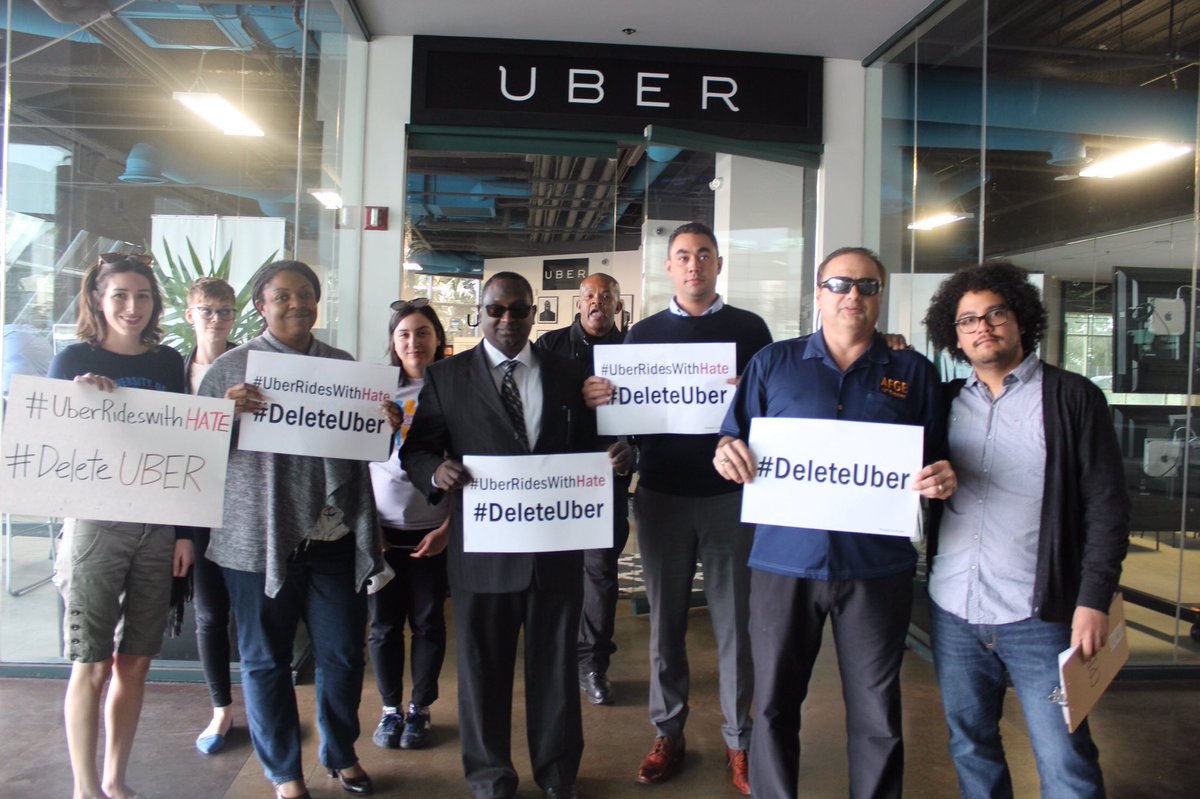
an Uber protest (photo: @CPIsd)
The following is an open letter from David Beier, president of the Committee for Taxi Safety to Commissioner Meera Joshi of the New York City Taxi & Limousine Commission:
Dear Commissioner Joshi,
In light of Uber's admission that it has shortchanged New York City drivers by millions of dollars, we urge you to immediately appoint an independent monitor to ensure all drivers are paid fairly and determine whether they are owed any additional money. Failure to swiftly appoint such a monitor would leave thousands of working-class New Yorkers at risk of wage theft.
Uber claimed that its failure to adequately pay New York City drivers was the result of an accounting error, but that is hard to believe since the practice continued unchecked for more than two years. This is also not the first time that the company has wrongly deprived its drivers of wages. Uber shortchanged drivers nationwide by manipulating navigation data, according to a class action lawsuit filed last month. The company was also forced to pay back Wages to Philadelphia drivers after it made an "error' earlier this year.
These numerous cases of apparent wage theft show that Uber cannot be trusted to guarantee fair payment for its 50,000 New York City drivers. An independent monitor would address this problem by providing direct oversight to ensure that all drivers are paid in full and on time. Such a monitor should also be tasked with investigating whether Uber has withheld any other wages from its New York City drivers.
The de Blasio administration has acted aggressively to address and prevent wage theft in various industries across New York City. This matter should be treated no differently.
Very truly yours,
David Beier
President, Committee for Taxi Safety
On Twitter @CommTaxiSafety
***
Have an op-ed idea or submission for Gotham Gazette? Email This email address is being protected from spambots. You need JavaScript enabled to view it.
Now More Than Ever, the City Must Invest in Adult Literacy
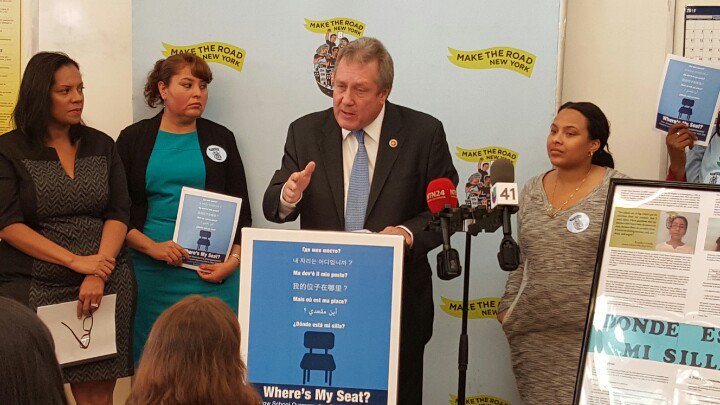
Council Member Dromm, one of the authors (photo: Make The Road NY)
Three million immigrant New Yorkers currently call our city home, adding to its vibrancy and vitality. Since Donald Trump’s election, immigrant communities have been fearful: hate crimes have gone up, immigrant workers face more exploitation, and families are scared of separation and deportation. For those of us working as community advocates and elected officials, we are now driven more than ever to find the policy solutions that will help our immigrant communities thrive and remain resilient, rather than live in fear.
Mayor de Blasio and City Council leaders have taken policy positions that do just that: committing to non-cooperation with Immigration and Customs Enforcement (ICE), pioneering an IDNYC program, maintaining strong worker protections, and increasing funding for universal pre-kindergarten (UPK) and the Community Schools initiative. Now, to more effectively protect and support our communities, we also need to deepen our investment in adult education and baseline in into the city budget.
Just a year ago the Mayor and Council invested $12 million for adult literacy, an increase that advocates called historic at the time. City leaders invested because the need is great, and for the thousands who study every year, the English classes offered by adult literacy providers give immigrants a pathway to economic mobility, social integration, parental support of children’s academic success, improved health outcomes, and greater civic engagement.
As immigrant communities live in fear and anxiety over federal immigration policy, it is essential that they are able to read and understand English—even as our city government is defending their rights and providing some protective services. Without English proficiency, many immigrants are left isolated and at risk of being taken advantage of by unscrupulous “notarios” who promise immigration relief for a fee, but never deliver. They are even more fearful than ever of accessing health and social services, challenged when applying for or improving work, and less able to support their children’s learning, or to report or stand up against employer, landlord, or police abuses.
Under the Trump administration, New York City’s largest source of federal adult literacy dollars (WIOA) is at risk of significant cuts. Even if the funding is maintained at a reduced level, current policy will likely make it more difficult to serve undocumented and low-level learners over time. For all of these reasons, this is the moment for the Mayor and Council to build on the momentum from last year’s investment and use their leadership to make New York City a model of adult literacy service provision. It is not too late, despite the fact that the Mayor’s most recent Executive Budget did not renew last year’s $12 million investment in adult literacy. A budget deal must be reached by July 1. The time is now.
Without the $12 million again this year, spots will be lost in literacy classes for over 5,500 adult students throughout the city, and an opportunity to deeply support immigrant New Yorkers will be lost. Last fiscal year's investment was critical to providers and students, and should be transformed into a baselined, multi-year investment in the field of adult education, allowing the city to update reimbursement rates for community based providers offering cost effective and critical services. In order to make our city a true 'sanctuary' city, we need to make it a city of opportunity for immigrants by ensuring that they have access to the literacy classes they need to thrive now.
***
Daniel Dromm is a member of the New York City Council. Theo Oshiro is the Deputy Director of Make the Road New York. On Twitter: @Dromm25 & @TheoOshiro.
***
Have an op-ed idea or submission for Gotham Gazette? Email This email address is being protected from spambots. You need JavaScript enabled to view it.
Mental Health Care is Key to Ending AIDS
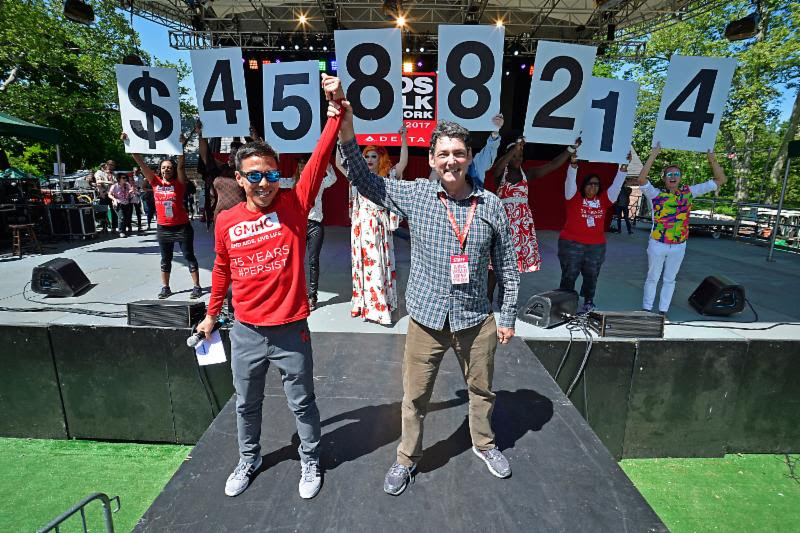
Kelsey Louie (left), the author, at the AIDS Walk (photo: Matthew McDermott)
From the days when HIV/AIDS first emerged, people living with HIV/AIDS faced horrible stigma, discrimination, hatred and rejection. Those touched by the epidemic also experienced trauma and depression. The emotional pain was searing; with little warning, AIDS robbed thousands of their family members, lovers, neighbors, and colleagues. People dealt with the shattering pieces of their lives as best as they could, often alone, and often with no professional help of any kind.
When Gay Men’s Health Crisis (GMHC), the first HIV/AIDS service organization in the world, was founded in 1981, services were developed based on the immediate needs of people coming through the doors, people with symptoms of AIDS, those who cared about people infected and affected, and the general public. Some came in need of care and support, others came for information or for assistance with grief due to the death of a loved one. In response, services were developed including a hotline to provide information, support groups for people with AIDS, buddy programs to provide care partners to the ill, and support groups for the families of people with AIDS or for those who were left behind after the AIDS death of a loved one.
Trained mental health professionals volunteered to facilitate many different types of support groups under the direction of a salaried clinical supervisor. People with AIDS were struggling with the psychological stress of an AIDS diagnosis, fueled by stigma, discrimination, anxiety, despair, and confusion. Short-term individual counseling was set up for people living with HIV to respond to those with urgent mental health needs, especially for those with AIDS Dementia Complex. At that time, GMHC’s primary jobs were to assist people to die with as much dignity as possible, to help those grieving the loss of a loved one to AIDS, and to provide all, including the broader public, with information about HIV/AIDS.
As new HIV medications were becoming available in the mid-1990s, GMHC’s group and individual counseling services continued to evolve. While HIV’s threat to a person’s physical health was well known, its impact on mental health was less clear, under-publicized, and not adequately researched. GMHC’s mission quickly changed; now it was our job to assist people to live with dignity—it is a mission that continues today.
Research shows a strong correlation between mental health disorders and people living with HIV and AIDS, a correlation that is often overlooked. According to the National Institute of Health, people with HIV have an increased risk for developing mood, anxiety and cognitive disorders, and are twice as likely to live with depression compared to those who do not have HIV. A 2010 United Kingdom study showed that one third of HIV-positive men who participated in the survey met the criteria for a post-traumatic stress disorder diagnosis.
For those living with HIV/AIDS, depression is more than just mental hell: it can be a silent killer. Studies show that if people living with HIV feel stigmatized or suffer from mental illness, they are less likely to take their medication properly, which not only puts their own health at risk by not suppressing the individuals’ viral load, but also raises the likelihood that they pass HIV on to others. Individuals living with HIV and depression are also more likely to think about suicide or even attempt to take their own lives.
Despite what we know about the connection between mental health and HIV/AIDS, too few people living with HIV/AIDS, and those invested in their health and happiness, are getting the mental health support they need. That is why we are proud to announce the opening of the state-of-the-art GMHC Carl Jacobs Mental Health Clinic, which will allow us to incorporate innovative treatment and counseling into our service model. Services will be available to adult New Yorkers of all sexual orientations, gender identities, and income levels, regardless of HIV status.
Past traumas, stress, depression, reduced self-esteem, and other challenges can be grueling to deal with. We aim to offer holistic services that address not only our clients’ mental health issues, but their social, spiritual, and health concerns as well. Meanwhile, the ability to reach more HIV-negative people with HIV preventative interventions and mental health services will allow us to help decrease new HIV infections.
It is now more than 35 years since the emergence of HIV/AIDS in the United States. New tools like PEP and PrEP mean we are closer than ever to ending the epidemic. But that dream will not become a reality until all people living with HIV/AIDS have access to the mental health care and services they need and deserve.
***
Kelsey Louie is the CEO of GMHC. On Twitter @KelseyLouieGMHC and @GMHC.
***
Have an op-ed idea or submission for Gotham Gazette? Email This email address is being protected from spambots. You need JavaScript enabled to view it.
New York Must Take Action Against Corporate Backers of Hate
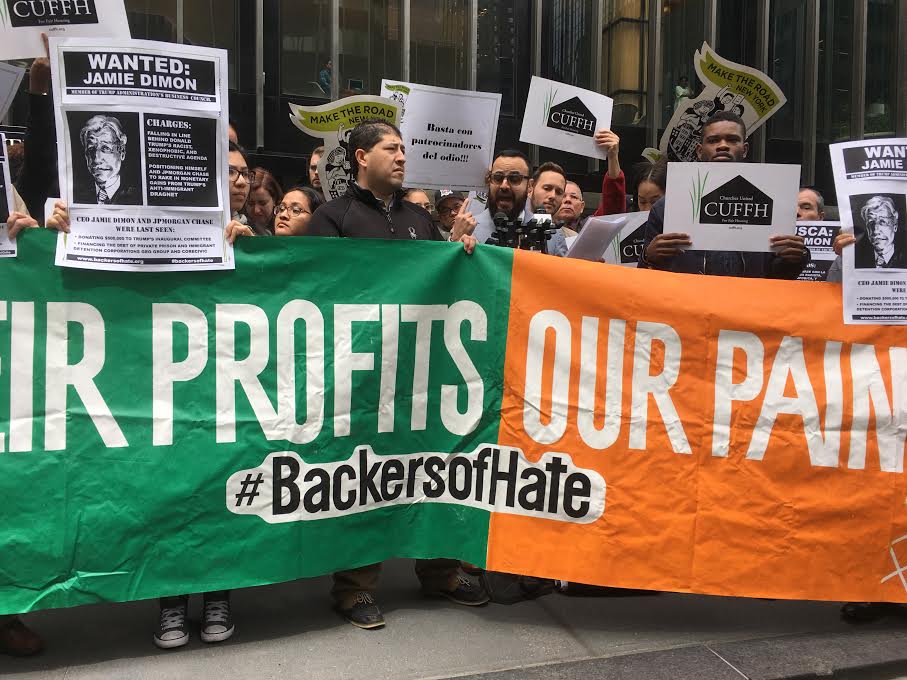
Assemblymember Moya, the author, speaks at a rally (photo: Make The Road New York)
Make the Road New York and the Center for Popular Democracy recently exposed President Trump’s corporate “backers of hate,” companies that stand to profit off an agenda so steeped in hate, prejudice, and greed, you would have to be willfully blind not to see it.
Nothing is more dangerous than business as usual when it is conducted in a moral vacuum, and these companies have been more than happy to go along for the ride: Goldman Sachs, Blackstone, JPMorgan Chase, Wells Fargo, Blackrock, Boeing, IBM, Uber, and Disney all seem eager to cash in on the Trump agenda.
Whether it's financing or investing in the detention centers necessary for Trump’s immigration crackdown, bidding on contracts with Immigrations and Customs Enforcement or Customs and Border Protection, supporting Trump’s campaign and inauguration, or spearheading an anti-worker agenda, the corporations share one commonality: they enable the most destructive and hateful policies of this White House.
Because Trump is great for business when that business is locking up people of color behind bars for petty crimes, and standing to gain from their imprisonment - as it is for JPMorgan Chase. A Trump White House is great for business when you stand to profit from breaking up unions, rolling back workers’ rights, and squeezing more from the middle-class. As for the overwhelming majority of Americans, those living paycheck to paycheck, struggling to afford their kid’s college education, or bracing for the sharp cuts to their health care, they are on the opposite side of that transaction; their pain is another’s profits.
The Backers of Hate campaign urges these corporations to reverse course, until they are no longer accessory to the crimes against the disappearing middle class, against the Muslims targeted by Trump’s travel ban, and to the immigrants living in constant anxiety that today will be the last day they’ll see their family.
And although these companies may not be swayed by the moral argument, they will listen when it comes to their almighty dollar. The Trump resistance must expand to include resisting his enablers. Consumers will need to apply the pressure where they can until condoning the Trump agenda is no longer a profitable business model.
But they don’t need to fight goliath alone.
As the finance capital of the world, New York not only has an obligation to pressure these companies, it has leverage. Our state pension fund is the third largest in the United States, with assets totaling $178.6 billion. In the weeks to come, I will introduce legislation in the state Assembly to divest that pension fund from companies guilty of the most egregious corporate complicity.
New York needs to lead the effort and draw a line in the sand. If you choose to benefit from the broad net Trump has given immigration enforcement agencies, from the deregulation and right-to-work campaigns that will bleed the middle class, or from the environmental degradation that endangers all of our futures, you’ve chosen to build upon a morally dubious house of cards. If New York is to truly stand in resistance to the Trump agenda, it’s time to put its money where its mouth is and disassociate itself from the backers of hate.
***
Francisco P. Moya is a New York State Assemblymember representing the 39th District in Queens and is the prime sponsor of the NYS Liberty Act and the NY DREAM Act. On Twitter @FranciscoPMoya.
***
Have an op-ed idea or submission for Gotham Gazette? Email This email address is being protected from spambots. You need JavaScript enabled to view it.
The Mayor's Moment to Show His Commitment to Seniors
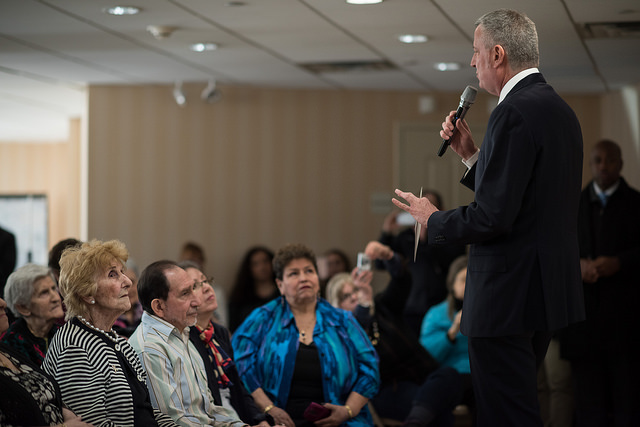
Mayor de Blasio speaks with seniors (photo: Michael Appleton/Mayor's Office)
As we age, we build momentum that is powering the economy, communities, and politics. Older people across the five boroughs are supporting local businesses, caring for their grandchildren, and participating in local politics. And yet we still find that many people aging into their later years cannot access this energy due to poverty, disability, and the lack of access to vital community services. We know almost one in three older New Yorkers struggles to make ends meet – living with painful, daily choices among food, medicine, and rent.
Over 40% report levels of disability and many older people struggle with social isolation, which research now tells us is a greater predictor of early death than obesity. Further, thanks to stagnant and antiquated city funding levels, over 800 are waiting since August for home care, while upwards of 2,000 are waiting for case management services that help people remain in their homes with modest assistance.
At first glance the issues seem overwhelming and unsolvable. But in fact, we already know what works and thankfully have an infrastructure here in New York to build upon. LiveOn NY represents a network of 100 member non-profit organizations that run roughly 800 programs in the five boroughs, including senior centers, meals on wheels, caregiver support, and case management. These programs provide critical community-based supports that together represent the foundation of an age-friendly city.
And this network of services is as diverse as our great city – providing assistance, classes, and programming that reflect every language, culture, nationality, and identity. Furthermore, we know that these services are not only culturally relevant and locally based but also efficient and effective. A recent New York City Department for the Aging study reports that seven in ten seniors attend their local senior center to avoid social isolation and over 20% found improved mental health through attendance. One out of four reported their physical health improved. These are important results and have incredible potential as people age into their seventies, eighties, and nineties.
So given the importance of these services in helping us age well and in our beloved communities, why is this network completely left out of the mayor’s budget priorities? Once again, we have an executive budget proposal from the mayor that shows a refusal to add any new funds to solve wait-lists or add capacity for future demand.
If Mayor de Blasio supports social justice and believes in progressivism, why does he leave out the later years of life? Are older New Yorkers exempt from social justice across the lifespan? And what about the daughter caring for her aging mother and her own children? She can count on universal pre-kindergarten for her young children yet nothing but waiting lists for her aging mother.
Mayor de Blasio ran on ending the tale of two cities. He recognized that the conditions in our wealthiest zip codes were only half of the story and that a truly progressive New York must create equitable opportunity for all. The chapters in that tale cannot end at age 60. We must ensure social justice across the lifespan. In addition to funding for the youngest and healthiest among us, the city budget must also include a robust plan that will support all of us as we age.
LiveOn NY, together with other advocates, has presented a $60 million budget plan to appropriately fund the city’s Department for the Aging. This needed support would begin to make the kind of investment in aging services that are needed. And beyond the budget, all of us must get involved in advocating for this inclusion. The foundation of aging services exists but needs serious additional investment in order to remain in place today and into the future.
Mayor de Blasio and the City Council have a choice - harness the momentum of later life by ensuring an equitable city budget or contribute to the tale of two cities. As New Yorkers, we pride ourselves on our ingenuity to develop solutions to challenging problems. We’ve often thought that the hidden secret of this city is the heart and willingness to work hard on behalf of our vulnerable neighbors. As we live longer, New Yorkers are seeking solutions to the challenges of aging and to the strong desire to remain engaged, involved citizens. Let’s lean in and move the momentum of older New Yorkers forward. Opportunities abound. But not without budgetary commitments to aging services.
***
Allison Nickerson is executive director and Bobbie Sackman is associate executive director of public policy for LiveOn NY. On Twitter @LiveOnNY.
***
Have an op-ed idea or submission for Gotham Gazette? Email This email address is being protected from spambots. You need JavaScript enabled to view it.
The Future of Latino Politics in New York City
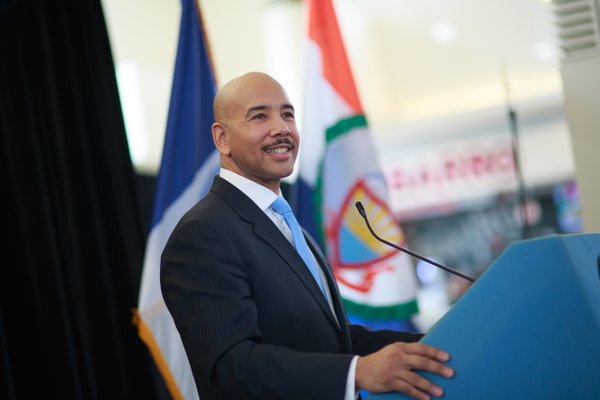
Ruben Diaz Jr. (photo: @rubendiazjr)
Just last month the annual Somos El Futuro legislative conference took place in Albany. Over 30 years ago a group of Latino elected officials and community leaders initiated the conference as a means to highlight issues important to Latinos and to shine a light on the plight of Latinos in New York. The visionary leadership of these early pioneers was to capitalize on and give consciousness to the ever-growing presence of Latinos in the state. Perhaps the name itself, Somos El Futuro -- We are the Future -- was not only a testament of the current influence of the Latino presence in New York at the time but also an apt moniker of the eventual significance of this surging community.
In a recent column, I highlighted the growing Latino electoral presence in New York City. Latinos now make up almost a quarter of the entire city electorate. Based on sheer numbers Latinos can now claim that they are not just the future but that estamos aqui ahora -- we are here now.
With this increasing presence has come a steady growth in Latino political representation, even though gentrification poses a real threat to some Latino-majority districts. The rise of the Latino presence citywide produced some noteworthy political leaders that in fact became pioneers and leading figures in our community. Among them we can note the work of Tony Mendez, Oscar Garcia Rivera, Herman Badillo, Olga Mendez, Angelo Del Toro, and Jose Rivera (who continues to serve in office).
Without a doubt, these pioneers have paved the way for a newer crop of Latino political leaders, many of whom are doing excellent work in their respective communities. Many are not only providing pivotal leadership in their districts, some have the potential to be serious and credible candidates for citywide office in the near future. It’s important to also note that the extremely important work of providing leadership in Latino areas—communities often riddled with rampant poverty, decrepit housing, and overcrowded schools—is not only being provided by elected officials. In fact, there are a number of Latino community activists, many of them young, fighting ardently for the justice that Latinos demand and deserve.
The last time a Latino gained a top spot on a citywide ballot was Fernando Ferrer in 2005. Prior to that it was Badillo, whose 1977 mayoral candidacy gained the affection of Latinos in New York (he also ran two more times for mayor). It is my belief that for the 2021 elections, Latinos can once again have a Latino (possibly more than one) launching a credible campaign for citywide office. The question is, who might these candidates be that can gain the attention of not only Latinos but also a wider electorate and public? Who will be the next Ferrer or Badillo?
The first that has to be highlighted is Ruben Diaz, Jr., the current Bronx Borough President. Very recently, Diaz, Jr. was a constant name in the ever-present rumor mill regarding a potential challenge to Mayor de Blasio. Diaz, Jr. instead has decided to seek re-election. Over the years, he has taken credit for a boon in Bronx development projects (something which in fact began occurring during Ferrer’s tenure in the borough presidency) and has been a fierce advocate for the people in his borough. While lacking the intellectual heft of a Badillo and Ferrer, Diaz, Jr. has a magnetic personality that is sure to attract many as his final term as borough president nears an end.
There is also Melissa Mark-Viverito, the current speaker of the City Council. Her position has given her the most Latino clout in recent years to influence citywide policy, some of which she has used. This platform has provided Mark-Viverito an ample opportunity to garner broad attention and to push for policy issues pertinent to a wider public and also to Latinos in particular. However, since she is term-limited and likely will be out of the public eye on a consistent basis, her chances for a successful citywide race in four years will be virtually impossible.
One person to keep an eye on is Ritchie Torres, a Bronx City Council member. Elected in 2013, at the youthful age of 25, Torres has proven to be a solid legislator, championing important causes, and also fighting ardently for better housing conditions for public housing residents. Torres is charismatic, well liked by his peers, and whip-smart. He has the uncanny ability to probe and articulate complex policy matters. At 29 years of age, Torres will surely be one to watch for years to come and could be a formidable candidate for either Bronx borough president or the city’s public advocate if he chooses to aspire to either position.
When looking at the horizon of Latino political leaders, the future seems bright -- the three aforementioned names are not the only ones on the list. With the continuing rise of Latinos in the overall population and increased voting participation, it may be quite possible that New York City will soon have its first Latino mayor.
[Also by Eli Valentin: Latino Voters and the 2017 New York City Elections]
***
Eli Valentin is a Democratic consultant and pastor of the Iglesia Evangelica Bautista in New York City. He is a frequent political analyst on Univision, and has appeared on NY1’s “Inside City Hall.” On Twitter @EliValentinNY.
***
Have an op-ed idea or submission for Gotham Gazette? Email This email address is being protected from spambots. You need JavaScript enabled to view it.
The ‘Worst State for Doctors’ Has a Dangerous Pre-existing Condition

photo
Another year, and another report naming New York the “Worst State for Doctors.” Time and time again, our state ranks dead last as a place for physicians to practice.
The primary reason for the Empire State’s strained relationship with the medical profession is the staggering cost of medical liability insurance. New York has the highest per capita medical liability payouts in the country. These payouts are 35 times higher, per capita, than they are in the lowest state. Nearly 20 percent of all the medical liability payouts in the U.S. are paid in New York, more than all of the medical liability payouts for the entire Midwest.
These costs drive doctors out of our state and weaken New Yorkers’ access to care. Since 2003, 16 hospitals in New York City have closed. To keep their doors open, some of the state’s remaining hospitals have opted to “go naked,” and not carry any medical liability insurance at all.
While it is tempting to blame the insurers for this cost crisis, many medical liability insurers are operating at a loss. The real culprit for New York’s runaway medical insurance costs is New York’s broken liability laws – laws that are bought and paid for by the state’s powerful trial lawyer special interest lobby.
The trial lawyer’s dominance over state government has created a disturbingly one-sided legal environment. For example, New York has no standards for expert witnesses, leading to “junk science” in the courtroom. Worse, there is no timeline for disclosure of experts, which allows personal injury lawyers to mask the merits of their case prior to trial. If doctors and their counsel do not know if the expert testifying in court is a world-class surgeon or a disbarred hack, they cannot adequately assess the evidence against them. This often leads to quick settlements, and an easy payday for plaintiffs’ lawyers.
Another boon for New York’s trial lawyers at the expense of our medical professionals is the state’s interest on judgments: the rate is currently fixed at an astonishing 9 percent. For doctors and their lawyers, running up 9 percent in interest is a major deterrent to filing an appeal. Whether cases are appealed or settled, resulting costs get passed on to patients.
New York’s spiraling medical insurance costs are not only endured by doctors and patients, they are put on the back of the taxpayer. Each year the state subsidizes the medical liability system with hundreds of millions of dollars in a desperate attempt to keep our doctors practicing here.
Many of the costs incurred by New York’s broken liability system are indirect. With the looming threat of lawsuits, many doctors practice “defensive medicine,” ordering more tests than needed. While these costs are not direct, each unnecessary procedure significantly raises the price of medical care.
But the crisis in our state’s medical liability system is not just an issue of cost and access, it is also an issue that impacts the doctor-patient relationship. New York’s current liability climate is so adversarial that physicians are dissuaded from making any statements of sympathy or apology for fear it will be used against them in court. Such statements are not only humane, but they have shown to reduce the time it takes to resolve medical liability cases. Thirty-six states have passed laws exempting statements of apology as an admission of guilt and liability. Not surprisingly, New York is not one of those states.
If the plaintiffs’ lawyers continue to get their way, lawmakers in Albany may actually make the situation worse, instead of addressing the issues discussed above. At the behest of the trial lawyers lobby, legislators are considering extending the statute of limitations on filing a medical liability claim. Enacting this proposal would undoubtedly lead to more lawsuits and even higher medical liability insurance costs. New York cannot continue to reign in last place; the Legislature needs to reject proposals that force talented medical professionals out of our state and focus on fixing the crisis at hand.
***
Thomas Stebbins is executive director of the Lawsuit Reform Alliance of New York. On Twitter @ThomasStebbins and @LawsuitReformNY.
***
Have an op-ed idea or submission for Gotham Gazette? Email This email address is being protected from spambots. You need JavaScript enabled to view it.
Our Plan To Save NYCHA Is Working, But Under Attack
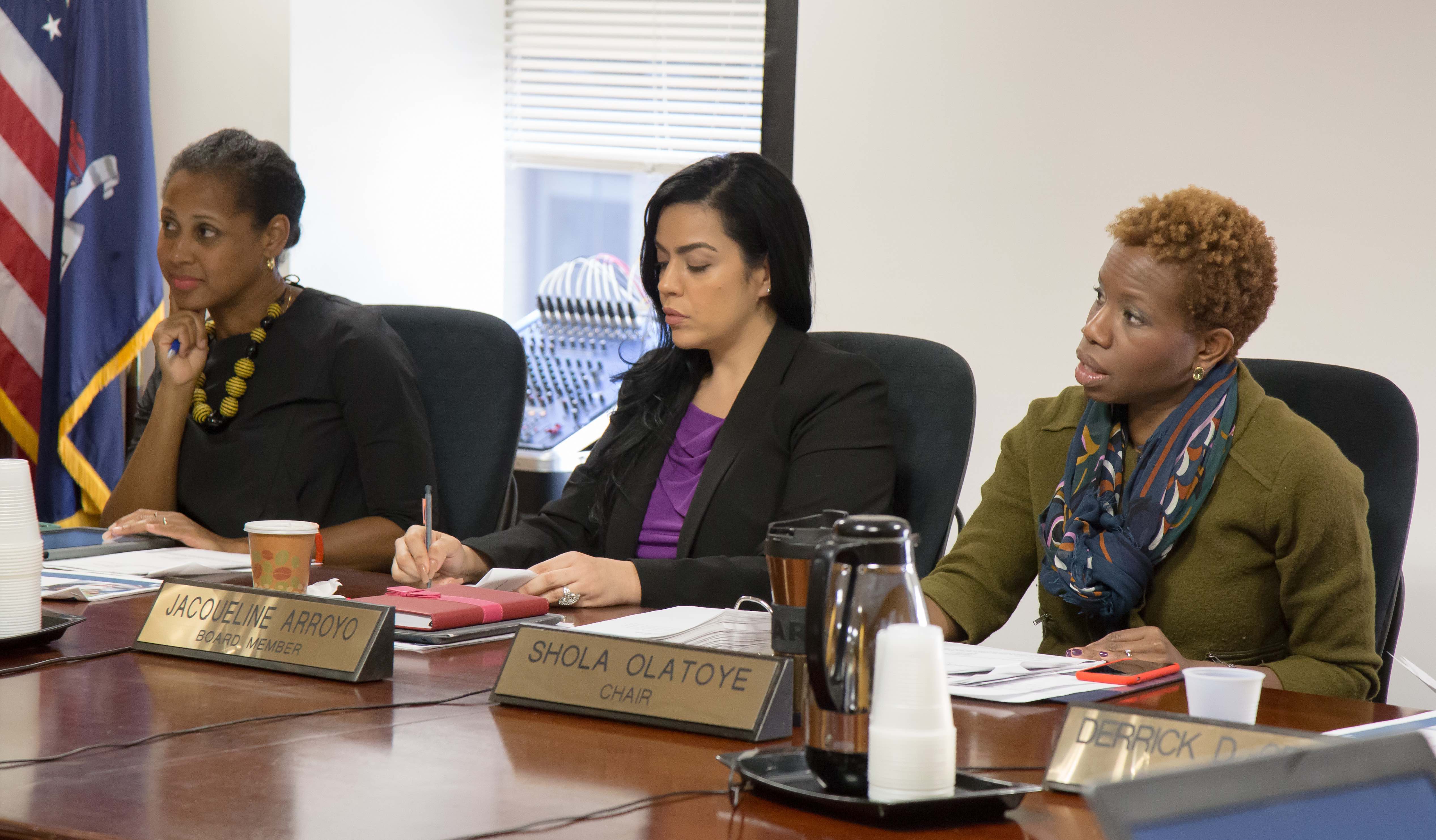
A NYCHA board meeting
Residents understand better than anyone what it means to live in public housing. On the second anniversary of the NextGeneration NYCHA long-term strategic plan, we find our homes under attack from the federal government.
As both residents and board members of the New York City Housing Authority (NYCHA), we have unique insight into the challenges facing the housing authority, but also the successes of NextGen NYCHA. Two years ago, when Mayor de Blasio and NYCHA Chair Shola Olatoye stood in front of residents, they announced a bold plan to put us on stable financial footing. They set out a path to better fund, operate, rebuild and engage developments. And despite numerous obstacles, as residents, we can say firmly, we have made progress.
NYCHA has increased revenue by almost $33 million, saved millions and become more efficient by implementing new technology, protected buildings by building new roofs, built almost 1,500 new affordable apartments, started 10 youth councils and placed almost 6,000 residents in new jobs. NYCHA and the brave officers of the NYPD have worked together to come up with new ways to secure developments and keep our families safer. When you mention funding as well as advances in technology and job placements there is still the human element to be considered. The list could go on.
What’s important though, is that residents are starting to feel these changes and feel their voices are being heard. Their vision is being broadened, resulting in a greater sense of responsibility for their environment, and ultimately residents feeling empowered to bring about change. NYCHA is listening to residents and is genuine in their mission to change the way they do business. Everyday they’re becoming better landlords. That doesn’t mean there isn’t work left to be done - there is. But we know that with Chair Olatoye and the team she and the mayor have put in place, they are moving in the right direction and lives are improving as a result.
Despite this remarkable progress, our buildings are in poor condition because of years of neglect by the federal government. Our roofs sag, the facades are crumbling and the pipes leak. Now, the president has proposed cutting over two-thirds of the budget dedicated to keeping our buildings standing, the capital budget. This is not about politics or parties, it’s about dismantling the future of public housing and jeopardizing the progress we’ve made on our long-term plan NextGen NYCHA. It is a horrific message to send to those who are the backbone of our society. In its simplest terms, these proposed cuts would lead to higher numbers of homelessness.
We are calling firmly on our partners to stand proudly with NYCHA and demand the federal government fully fund public housing. Obstruction and budget cuts are not the road ahead for solving the housing crisis in the city. For many, NYCHA is what stands between them and homelessness. With over half a million residents, NYCHA housing is the size of Miami, and will always have room for improvement, but it is essential that we consider humanity first, before economics. If public housing isn't adequately funded, we will devastate working families, counter to the roots of public housing in our city and country. During this crisis, when the very existence of public housing is threatened, it’s time to come together to protect the lowest income New Yorkers and save NYCHA.
***
The authors are Resident Board Members of the New York City Housing Authority.
***
Have an op-ed idea or submission for Gotham Gazette? Email This email address is being protected from spambots. You need JavaScript enabled to view it.




